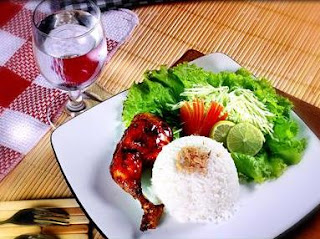 If you went to Banjarmasin (the capital city of South Kalimantan), one thing you should not miss is Sasaringan. It is a traditional motif cloth from Banjar ethnic. Literally, Sasaringan means "straight line" in Banjar dialect. In fact, this cloth is having pictures and colors that made in vertical (from top to bottom) straight line.
If you went to Banjarmasin (the capital city of South Kalimantan), one thing you should not miss is Sasaringan. It is a traditional motif cloth from Banjar ethnic. Literally, Sasaringan means "straight line" in Banjar dialect. In fact, this cloth is having pictures and colors that made in vertical (from top to bottom) straight line.Sasaringan has been known since 13th century. In the beginning, this cloth been called Langgundi (yellow weaving cloth) because it usually made in yellow color. The Langgundi cloth had become daily cloth than been wore by people in Banjar when Empu Jatmika become The king of Dipa (Banjarmasin) in 1355 - 1362. At that time, there was a city called Amuntai, that became a central of Langgundi production. Since 1365, people starting to develop Sasaringan. And since then, Langgundi had been replaced by Sasaringan because the the design of Sasaringan weaving is better than Langgundi.

Even not popular anymore, Langgundi is still available until today. Usually it's been used for special healing ritual as wrapper or headband.
The oldest Sasaringan that still available right now is belong to Mrs Ida Fitriah Kusuma, one of the resident of Banjarmasin. She has a 300 years old of Sasaringan which she received from her great-grand mother. On July 24, 1982, Mrs Ida Fitriah Kusuma gathered housewives of Banjarmasin who have intention of Sasaringan, and formed Banawati's Sasaringan Weaver Group (Kelompok Kerja Pembuat kain Sasaringan Banawati). This group has intention to introducing the cloth to younger generations, so the cloth will not extinct and they can keep the cloth as their heritage.
 Starting 1985, The Governor of South Kalimantan Ir. HM Said instructed all Governmental officers to wear dress and uniform that made from Sasaringan cloth in every Friday. Until today, the instruction still followed and you still can see all government officers wear Sasaringan cloth uniform in every Friday.
Starting 1985, The Governor of South Kalimantan Ir. HM Said instructed all Governmental officers to wear dress and uniform that made from Sasaringan cloth in every Friday. Until today, the instruction still followed and you still can see all government officers wear Sasaringan cloth uniform in every Friday.Most tourists that visiting Banjarmasin will look for Sasaringan cloth. Besides the design is nice, you can feel the marvelous softness of this hand-weaving cloth. The cloth is sold widely in a lot of places in Banjarmasin. The price of Sasaringan cloth is depending on the motif and the type of the fabric. The more difficult design that been used, the more expensive the price.
Sasaringan cloth recently has been made in several variants of fabric, such as sateen, silk, cotton, or santung (rough silk cloth). Especially for silk, there are two kinds of it : Grand Silk (second grade silk) and Super Silk (first grade silk). Sasaringan cloth usually sold in pieces. Each piece consist of 2 meters (for top making, such as shirt),3 meters (for pant), 5 meters (for uniform top and bottom), and 7 meters (for complete part of ladies dress). The price of the cloth is between Rp 60,000 to Rp 75,000 / meter (approx. US$ 6,5 - 8 / meter).
 But if you have no time to sewn the cloth, you can look for its shirt or dress in well-known mall around Banjarmasin, such as Duta Mall or Citra Sasaringan (near Pasaraya Citra).
But if you have no time to sewn the cloth, you can look for its shirt or dress in well-known mall around Banjarmasin, such as Duta Mall or Citra Sasaringan (near Pasaraya Citra).If you want to have a long-lasting sasaringan cloth that can kept for years, here are some tips to taking care of this cloth or shirt :
1. Separate Sasaringan cloth from other shirt when you do first time washing, because the color of sasaringan cloth usually faded.
2. Don't dry it in the sun directly.
So...if you visit South Kalimantan, remember to look for Sasaringan. Because if you leave Banjarmasin without it, people won't believe you ever been there. Trust me..... it's true....























